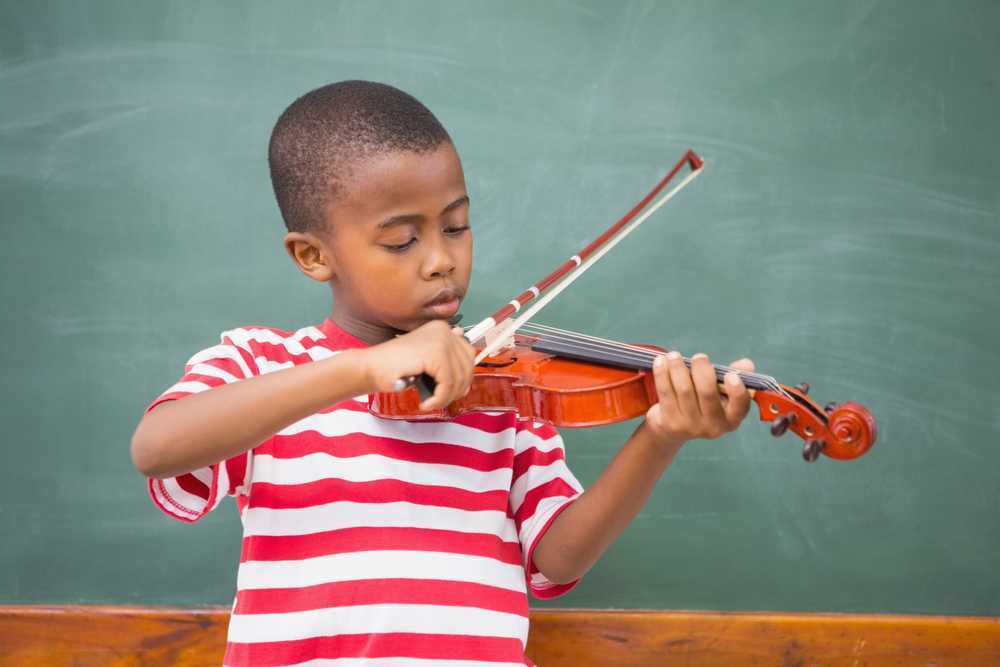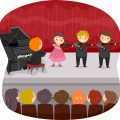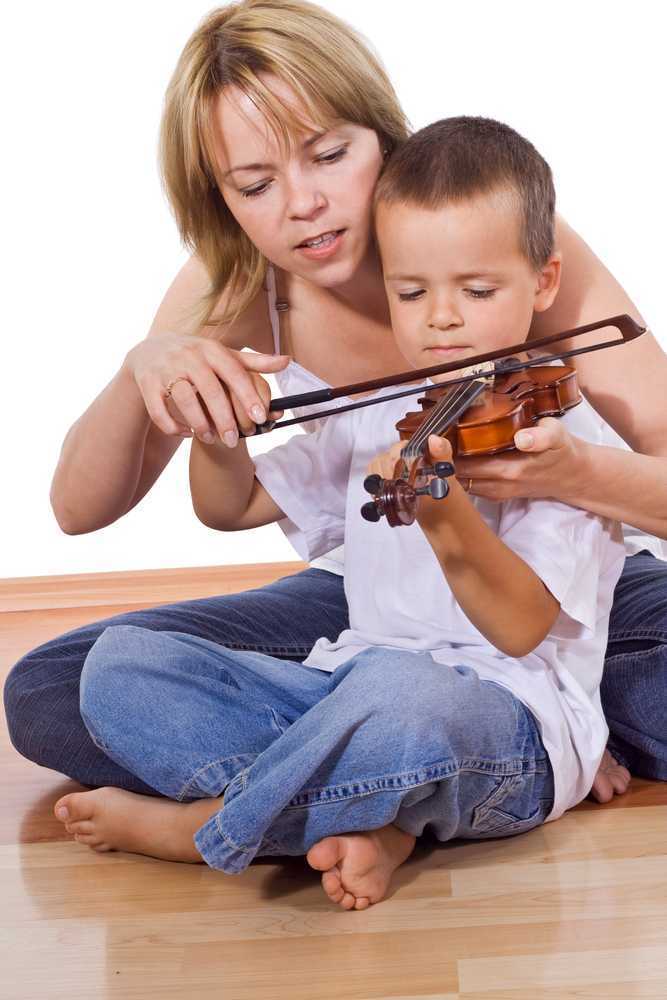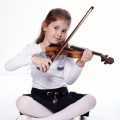The Pros and Cons – and What You Can Expect
What are your thoughts on allowing siblings in the Suzuki studio? In the musical world, the opinion on extra children in the music studio can be varied and very colorful. It ranges from the ascetic requirement of student and teacher onlY (no one else!) to a very free and open vibe of parents, teacher, student, siblings, extended family, and anyone else who wants to observe.
Every teaching method is going to be different, as will every music teacher’s expectations. If you are still figuring out your own teaching preferences, or you are a parent trying to understand why studios handle siblings in the music studio differently, then consider some of the following ideas.
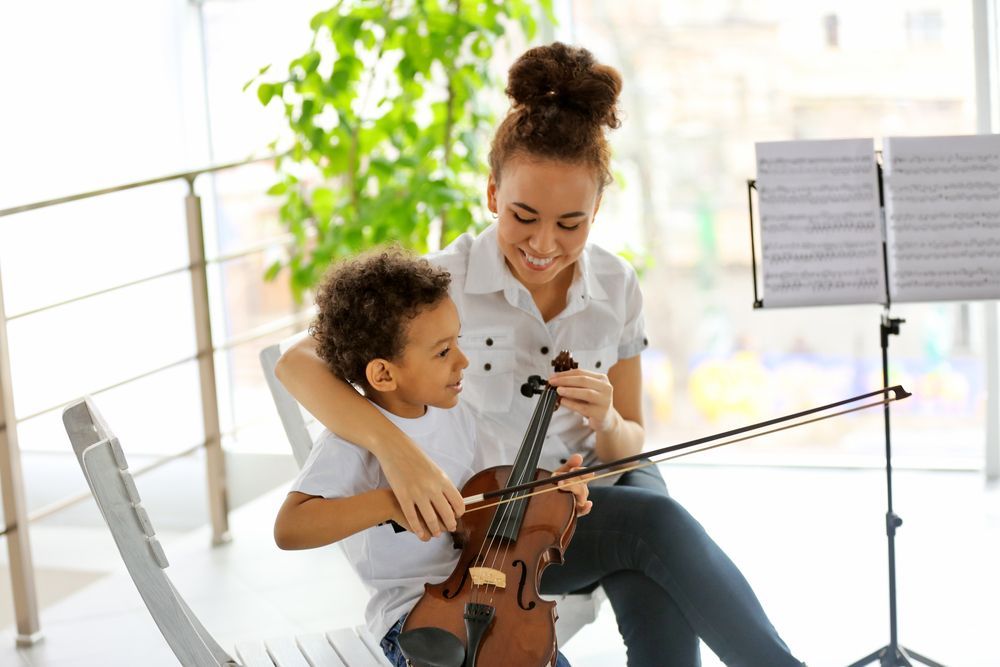
Suzuki Studio Lesson History
If you ever take Suzuki Teacher Training from someone who studied music with the founder of the program, Shinichi Suzuki, you will frequently hear the teacher refer to Suzuki’s open lesson concept. Students would gather in the lesson room and Suzuki would give individual lessons to each person with the whole room full of people looking on. While each student would only have a set amount of lesson time with the teacher, these lesson sessions could go on for hours.
It was like a giant teacher training seminar. As in any other job training situation, examples of what to do (and what not to do) were a necessary part of the learning process.
Ultimately, what was happening was that everyone was learning from each lesson that was held. Perhaps one student worked on her bow arm during the time she was with Suzuki, but she might also see a lesson in tone production, vibrato, or any number of other topics. In essence, she was learning from all the lessons, not just hers.
Suzuki Today
Let’s fast forward to the Suzuki studio now. The concept that Suzuki imparted – that of having semi-private lessons – is still widely used in the Suzuki method. You’ll see it utilized in both regular music studio work and at summer institutes. While some studios may keep it down to having only the parent and student in the studio with the teacher, institutes will probably have three students plus their parents observing as the teacher works with the fourth student. Siblings of the students may also be present, in addition to teacher trainers who are observing.
While the parent of a student is expected to take notes on his or her child’s lesson, students, too, are sometimes encouraged to take notes on what happens in each other’s lessons. This allows the student having the lesson to focus on the music instead of trying to record everything at the same time. And, the observing students learn as they take notes. There is also the benefit of peer learning: say one student in the small lesson group is working on his bow hand. The next student, who may be working on her right shoulder, will have already heard about why arm posture is important. Giving this information in one lesson instead of four different lessons cuts down on how much the teacher has to repeat herself, and it gives students (and their listening parents) a wider grasp of what the big picture of making music is.
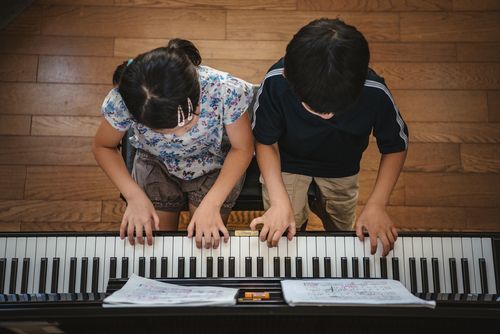
Teacher-Parent-Student Triangle Plus
Suzuki teachers are encouraged to utilize the teacher-parent-student triangle. This means that in the lesson, the teacher is the primary instructor, the student is actively filtering through the teacher’s instructions, and the parent is taking notes. The parent uses his or her notes to help the student during home practice – the parent becomes the ‘home teacher.’ This is especially useful with young children, as a toddler or preschooler will definitely have a hard time remembering how to do everything himself for a structured practice session at home. (Remember, practice sessions do not have to be grueling two hour events: fifteen minutes for very young players is usually enough for the day.)
So here, the ‘open’ studio concept is fairly limited to three necessary participants. But what happens when there are siblings or friends?
Good question. Very often, for a family that has decided to use the Suzuki method, the student will have other siblings who may also be taking music lessons – sometimes, even for the same instrument. Some families like to have their lessons take place in the same block of time. For example, if the family has three children, they will have lessons from 3:30 p.m. – 5 p.m., one right after the other.
It’s tempting, as the teacher, to expect everything to go as smoothly as it did when you took lessons – rules for the studio may not seem very necessary. But in the real world, teachers have to have some ground rules so that students and their families and friends understand what the teacher’s expectations – and what the building regulations – are. If you are the teacher, check out these tips for helping your Suzuki studio run as smoothly as possible.
Start By Having Ground Rules
Prepare a lesson packet that outlines the basic rules of coming to the studio. Do you have a policy for students who arrive early? Late? Where can they sit? Do they knock before coming in? Should they take off their shoes or leave them on? What about food or drinks in the room? Or how about the family that is babysitting for the afternoon, and brings along an extra toddler? Think about your studio space, and plan for what will work in that area.
The Quiet Studio
Some teachers want the studio to be very quiet. The student having the lesson is the focus, and extra children/students in the room are encouraged to take notes, so that they can also learn from the lesson. Teachers may ask other students during their own lessons, “Remember what Jonah was doing? Can you do that, too?” Or they will say, “Yes, because Susie is in Book 1, she’s still mastering this skill. You’re in Book 3, so you can take it a step further.”
Teachers that strive for this type of environment are very serious about helping students learn good technique. By really focusing on what is happening during the instructional time, the teacher is encouraging students and parents to focus strongly on the goals of the lesson.
The More Relaxed Studio
In the more relaxed studio, there will probably be a little more physical space. The teacher may have a play table or a few small chairs for the siblings in the Suzuki studio. The parent is expected to take notes and the student is expected to focus, but the siblings who are waiting may be able to do other quiet activities.
While this is a more open environment, the goal is still to concentrate on learning. In this situation, the teacher might get up and ask the students as a group about something in music theory, or she could have one of the waiting siblings get out his instrument and play with the sibling having the lesson.
Ultimately, studio rules usually hinge heavily upon how much space there is, and upon the teaching style of the instructor. In a tight studio, motion and noise will be very distracting. In a larger studio, a little more action can be accommodated – within reason. The teacher determines what will work for the space that is there.
Lesson Dos and Don’ts: What to Tell parents
When it comes to siblings in the Suzuki studio, practicality is usually the best guide. Yes, lessons should be enriching, but common sense may indicate that some activities aren’t right for the whole group at all times. Consider the following:

- Very young children – like infants – can’t be silent for a great length of time. They are needy little individuals, and their lives depend on attentive care. If one of your student families has a new baby, let them line up childcare. Some families bring both the mom and dad, so that they can tag team caring for the young ones. Baby goes out for a bottle, and the lesson continues in peace and quiet. This includes toddlers: if someone is just getting too fidgety, let Dad take him on a walk.
- Siblings or friends who are not babies need to be able to focus. Remember the rule of thumb for potential Suzuki students: if the child can stand quietly and listen to the entire tune of “Twinkle, Twinkle Little Star,” he is ready for lessons. The same applies to being in the studio. If a child can’t sit still, parents will want to make arrangements so that the child can safely be taken outside when he has had enough.
- When it comes to noise, don’t be worried about small stuff. Dropping a pencil or having the cell phone ring accidentally isn’t a major incident. Let the parent deal with the disruption quickly and move on. We know that accidents happen.
- Remember that the parent is responsible for actions taken by siblings or friends in the studio. The teacher focuses on teaching, not on child care. It is the parents’ role to maintain order and keep things under control in the sibling/visiting children department while the teacher is guiding the lesson.
Sample Rules of the Suzuki Studio
If you are the teacher just setting up the studio, here are some sample studio rules that may help you maintain order:
- No running or shouting. (This prevents injury, as well as eliminating an obvious distraction. If the teacher wants to run and shout, that is her prerogative.)
- Sit quietly during other students’ lessons. (A wandering pupil is a distraction to the teacher as well as to the other students. Wandering children may be taken out of the room.)
- If the teacher is sick, or one of the students or siblings is ill, it is a very good idea to reschedule the lesson.
- No food or drink in the room. Some teachers are very strict about this. There is nothing quite so disruptive as a burger wrapper crackling, unless it’s the smell of fresh, hot, crispy and salty French fries. And when it comes to cracking ice from a drink… this can really be disruptive. There’s a practical reason for food rules, too: musical instruments should never be handled with greasy or gooey hands. And, if something spills, the teacher is responsible for the (expensive) cleaning bill for the studio space.
- Friends, relatives, or extra kids should be brought only with the permission of the teacher. There may be fire code limits to the number of people allowed in the room; or, the teacher may want to freshen up the studio and grab more chairs before a whole crowd comes in.
- No noisy toys. Building bricks are fun, but push a bucket of those over and the idyllic learning atmosphere is shattered. Ditto for cars with sirens and loud tablet games.
- If a child needs to be taken outside for any reason, just let it happen. A parent holding a loudly crying toddler halfway in and out of the studio as she tries to listen to the lesson is not a solution for any of the parties involved.
Siblings in the Studio: Rewards and Unintentional Consequences
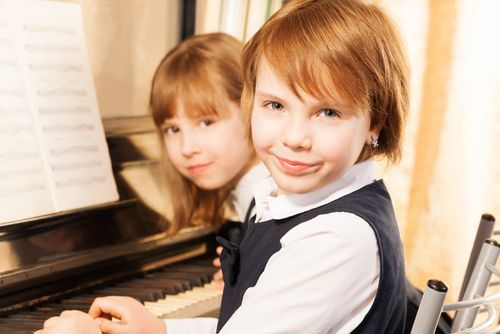 Let your studio parents know that sometimes, an abundance of quiet activities may backfire if the student taking the lesson notices that someone else is getting a quiet treat or that little sister gets to play with Dad’s iPhone. “I want to do that, too!” thinks the child. And then, the twisting, turning, and not paying attention syndrome hits.
Let your studio parents know that sometimes, an abundance of quiet activities may backfire if the student taking the lesson notices that someone else is getting a quiet treat or that little sister gets to play with Dad’s iPhone. “I want to do that, too!” thinks the child. And then, the twisting, turning, and not paying attention syndrome hits.
Suggest to parents that they have a few things that everyone gets to sample. Notebooks (for taking extra notes), coloring books with crayons or colored pencils that are only used during lessons, or other items like this are useful for kids of all ages.
The Purpose Wrapped Up
Having siblings in the studio is meant to be an enhancement to the educational atmosphere of all the people involved. In the perfect world, the students benefit because they have positive peer re-enforcement. The parent is able to keep tabs on the lesson, and to make sure that the other children in the family are together, in a safe environment (i.e. not wandering the halls and falling down stairs). And the teacher gets to guide not just one student at a time, but several, along sound principals in music making. Families with multiple children who take lessons together give a distinct advantage to the younger students, who have grown up hearing the music and watching the process their whole lives.
While every day in the studio will not be perfect, quality music education is the goal for which we strive. Having siblings in the Suzuki studio is just one part of the whole process.


